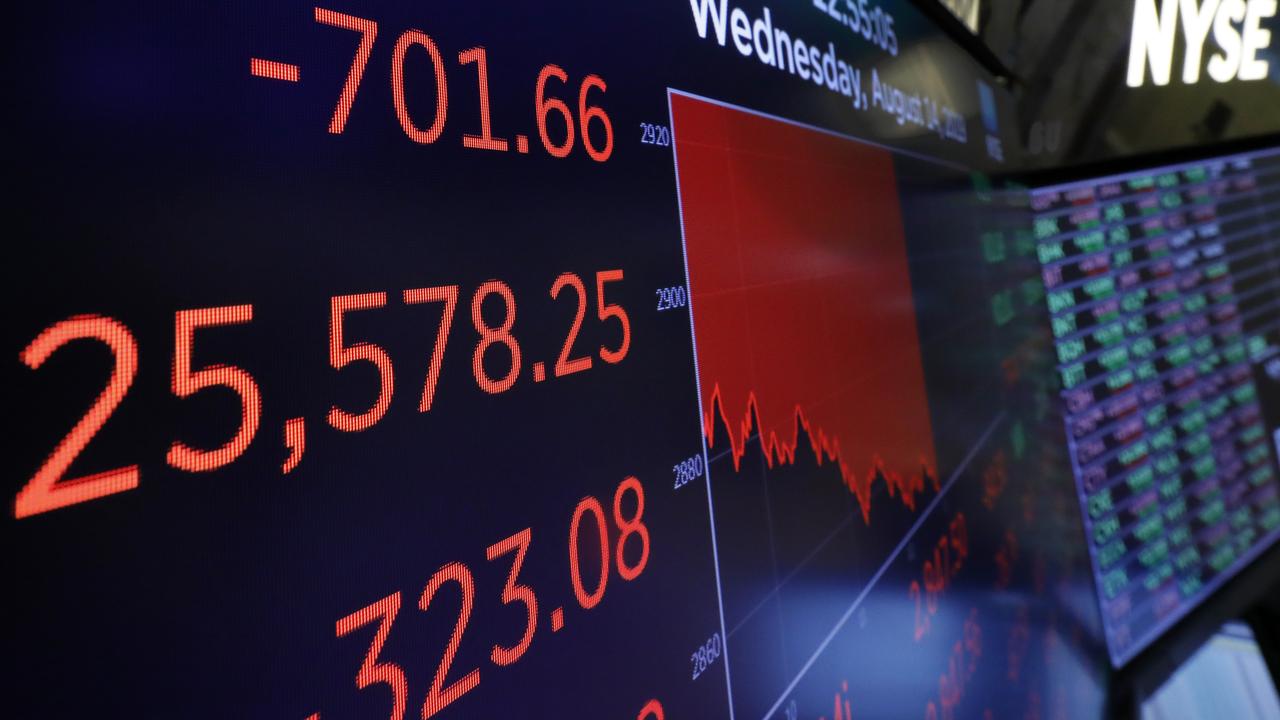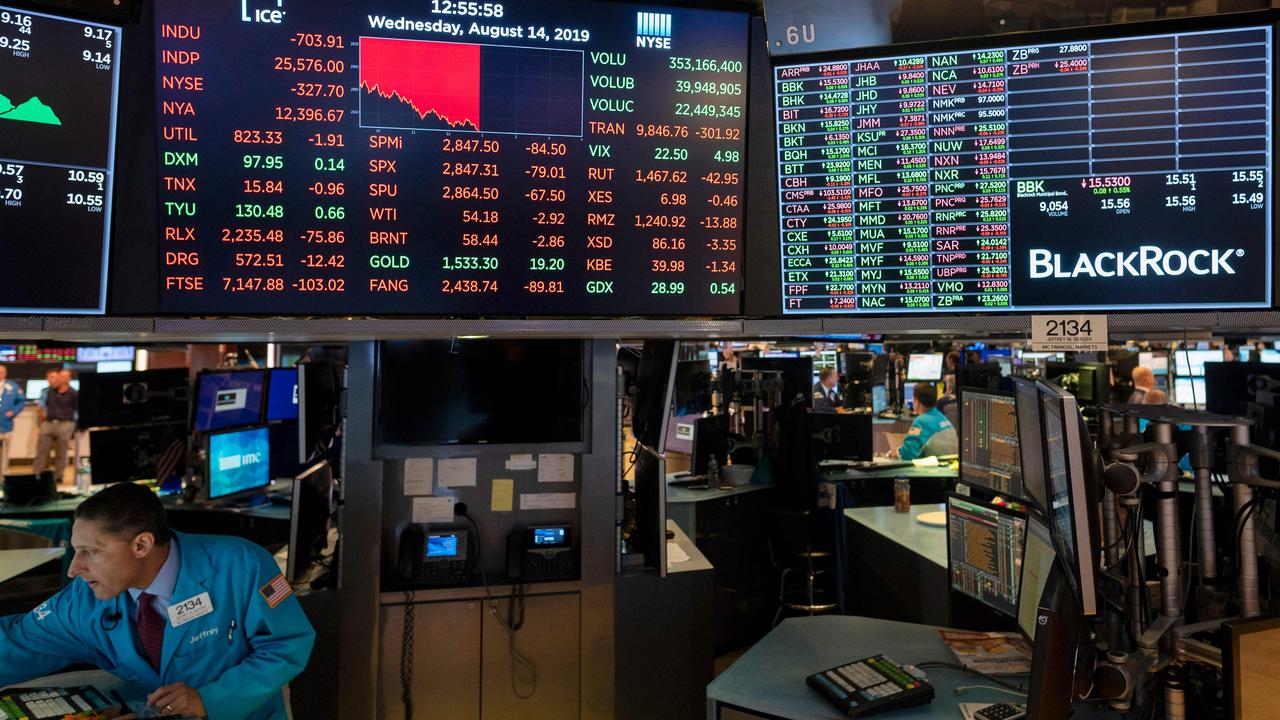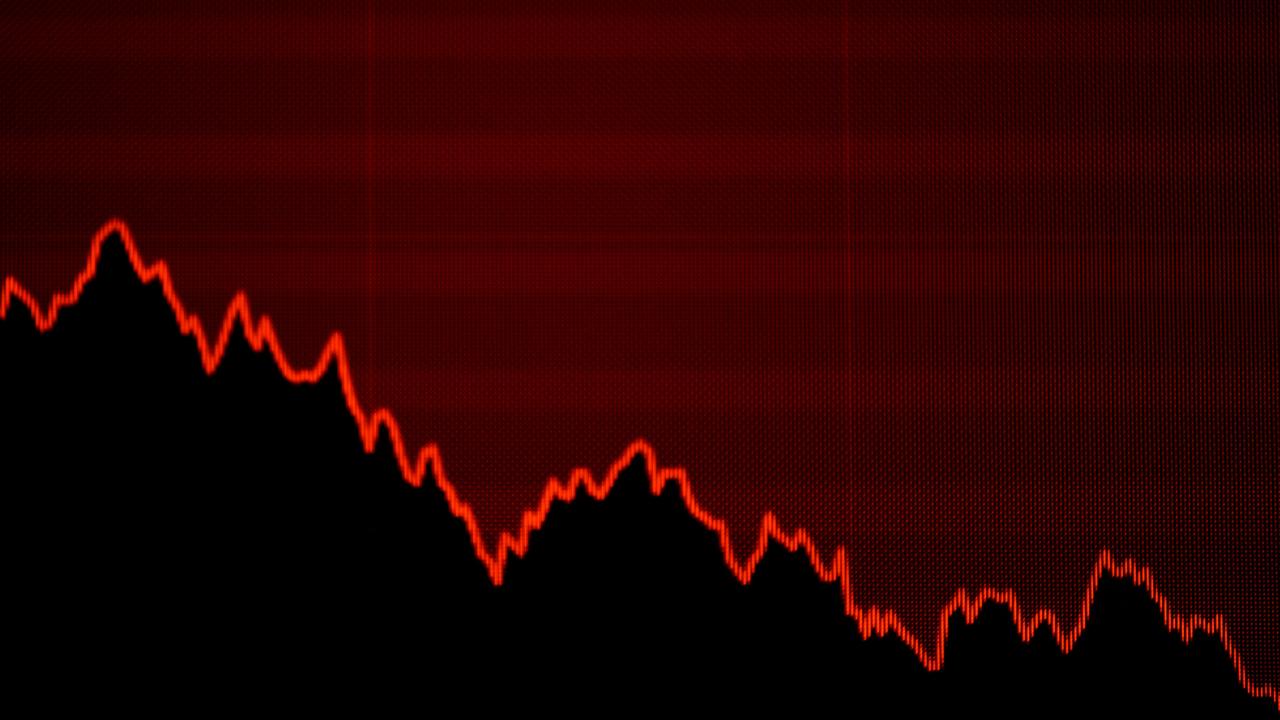‘Crazy inverted yield curve!’: $63 billion wiped from ASX after Wall Street bloodbath
Losses on the ASX have deepened to more than $63 billion after a Wall Street bloodbath sparked by rising fears of a global recession.
The Australian share market has shed more than $63 billion in its worst day in 18 months amid a global market meltdown as investors fear a recession is near.
US President Donald Trump lashed out on Twitter to defend his economic policies after a “crazy” recession warning light flashed red, sparking a bloodbath on Wall Street as investors brace for a global crash.
Just after 1pm the official ASX website appeared to be suffering under the strain, displaying a “service temporarily unavailable” error. “This service is temporarily unable to service your request due to maintenance downtime or capacity problems,” it said. “Please try again later.”

By 1:30pm, however, the website appeared to be functioning normally.
The benchmark S&P/ASX200 index on Thursday tumbled 187.8 points, or 2.85 per cent, to 6,408.1 points, while the broader All Ordinaries shed 186.7 points, or 2.8 per cent, to 6,490.8 points.
It was the market’s worse day since February 6, 2018, when the ASX200 lost 192.9 points, or 3.2 per cent.
The Aussie dollar is buying 67.83 US cents from 67.82 US cents on Wednesday.
Stock broker [who is a dog]: seems fine to me pic.twitter.com/tPGlJNzSJP
— Alex Druce (@AlexDruuuce) August 15, 2019
RECESSION WARNING LIGHT
The yield on the closely watched 10-year US Treasury fell so low Wednesday that, for the first time since 2007, it briefly crossed a threshold that has correctly predicted many past recessions. Weak economic data from Germany and China added to recent signals of a global slowdown.
That spooked investors, who responded by dumping stocks, sending the Dow Jones Industrial Average into an 800-point skid, its biggest drop of the year and fourth largest daily point drop on record.
The S&P 500 index dropped nearly 3 per cent as the market erased all of its gains from a rally the day before. Tech stocks and banks led the broad sell-off. Retailers came under especially heavy selling pressure after Macy’s issued a dismal earnings report and cut its full-year forecast.
Investors have been ploughing money into the safety of US government bonds for months amid growing anxiety that weakness in the global economy could sap growth in the US. Uncertainty about the outcome of the US trade war with China has spurred a return of volatility to the stock market in August — the Dow has dropped more than 5 per cent and the S&P 500 is down more than 4 per cent.
..Spread is way too much as other countries say THANK YOU to clueless Jay Powell and the Federal Reserve. Germany, and many others, are playing the game! CRAZY INVERTED YIELD CURVE! We should easily be reaping big Rewards & Gains, but the Fed is holding us back. We will Win!
— Donald J. Trump (@realDonaldTrump) August 14, 2019
Economic data from two of the world’s biggest economies added to investors’ fears Wednesday. European markets fell after Germany’s economy contracted 0.1 per cent in the spring due to the global trade war and troubles in the auto industry. In China, the world’s second-largest economy, growth in factory output, retail spending and investment weakened in July.
“The bad news for global economies is stacking up much faster than most economists thought, so trying to keep up is exhausting,” Kevin Giddis, head of fixed income capital markets at Raymond James, wrote in a report.
The S&P 500 fell 85.72 points, or 2.9 per cent, to 2,840.60. The Dow sank 800.49 points, or 3 per cent, to 25,479.42. The Nasdaq composite lost 242.42 points, or 3 per cent, to 7,773.94. The Russell 2000 index of smaller company stocks slid 43.05 points, or 2.8 per cent, to 1,467.52.
The losses come a day after stocks rallied when the Trump administration delayed tariffs on about $US160 billion in Chinese goods that were set to take effect on September 1.
Mr Trump took to Twitter to defend his trade policy Wednesday, saying “we are winning big time, against China”.
But many on Wall Street remain worried that the trade war between the world’s two largest economies may drag on through the 2020 US election and cause more economic damage. “We still see a substantial risk that the trade dispute will escalate further,” said Mark Haefele, global chief investment officer at investment bank UBS in a note to clients.
Mr Trump also criticised the Federal Reserve for hamstringing the US economy by raising rates “too much & too fast” last year and not reversing its policy aggressively enough — the Fed cut its key rate by a quarter point last month.
“Companies & jobs are fleeing. Prices to us have not gone up, and in some cases, have come down. China is not our problem, though Hong Kong is not helping. Our problem is with the Fed. Raised too much & too fast. Now too slow to cut,” he tweeted.
“Spread is way too much as other countries say THANK YOU to clueless Jay Powell and the Federal Reserve. Germany, and many others, are playing the game! CRAZY INVERTED YIELD CURVE! We should easily be reaping big Rewards & Gains, but the Fed is holding us back. We will Win!”



WHAT IS THE YIELD CURVE?
Traders tend to plough money into ultra-safe US government bonds when they’re fearful of an economic slowdown, and that sends yields lower.
When longer-term Treasurys fall below shorter-term ones, economists call it an “inverted yield curve”. An inverted curve suggests that bond investors expect growth to slow so much that the Federal Reserve will soon feel compelled to slash short-term rates to try to support the economy.
In short, it’s a sign of economic pessimism.
The yield on the 10-year Treasury has dropped from 2.02 per cent on July 31 to below 1.60 per cent and on Wednesday, it briefly fell below the two-year Treasury’s yield for the first time since 2007.
Each of the last five times the two-year and 10-year Treasury yields have inverted, a recession has followed. The average amount of time is around 22 months, according to Raymond James’ Mr Giddis.
The indicator isn’t perfect, though, and has given false signals in the past. After its early dip, the yield on the 10-year Treasury stood at 1.58 per cent, even with the yield on the two-year. Meanwhile, the 30-year Treasury yield also hit a record low Wednesday.
“Historically, the two-10 has had better predictive ability of recession than equities,” Sri Kumar, president of California-based Sri-Kumar Global Strategies, told Fox Business.
“If you depended on equities to tell you whether you are entering into a recession you did not do well. For example, October, November of 2006, exactly one year before the Great Recession began, the 2-10 inverted. Equities did well in the first half of 2008 when we were in a recession and oil prices hit a peak in May of 2008 when we were very much in a recession.”
He added, “Do not depend on equities or oil price to tell you that you are in a recession. You’re probably not going to do well as a leading indicator.”
Other parts of the yield curve have already inverted, beginning late last year. But each time, some market watchers cautioned not to make too much of it. Some say the yield curve may be a less reliable indicator this time because technical factors may be distorting longer-term yields, such as negative bond yields abroad and the Federal Reserve’s holdings of $US3.8 trillion in Treasurys and other investments on its balance sheet.
With bond yields falling, banks took heavy losses Wednesday. Lower bond yields are bad for banks because they force interest rates on mortgages and other loans lower, which results in lower profits for banks. Citigroup sank 5.3 per cent and Bank of America gave up 4.7 per cent.
Macy’s plunged 13.2 per cent, the sharpest loss in the S&P 500, after it slashed its profit forecast for the year. The retailer’s profit for the latest quarter fell far short of analysts’ forecasts as it was forced to slash prices on unsold merchandise. The grim results from Macy’s sent other retailers sharply lower, too. Nordstrom sank 10.6 per cent and Kohl’s dropped 11 per cent.
Energy stocks also sank sharply, hurt by another drop in the price of crude oil on worries that a weakening global economy will drag down demand. National Oilwell Varco slumped 8 per cent and Schlumberger skidded 6.6 per cent.
The price of benchmark US crude slid $US1.87, or 3.3 per cent, to settle at $US55.23 per barrel. Brent crude, the international standard, dropped $US1.82 to close at $US59.48.
Wholesale gasoline fell 6 cents to $US1.68 per gallon. Heating oil declined 4 cents to $US1.84 per gallon. Natural gas fell 1 cent to $US2.14 per 1000 cubic feet.
Gold gained $US13.70 to $US1,515.90 per ounce, close to a six-year high. Investors also bid up shares in mining company Newmont Goldcorp 0.8 per cent.
Silver rose 29 cents to $US17.25 per ounce and copper fell 3 cents to $US2.59 per pound.
The dollar fell to 105.88 Japanese yen from 106.68 yen on Tuesday. The euro weakened to $US1.1137 from $US1.1174.
Overseas, Germany’s DAX dropped 2.3 per cent following the weak German economic data. France’s CAC 40 fell 2.2 per cent, and the FTSE 100 in London lost 1.7 per cent. In Asia, Japan’s Nikkei 225 rose 1 per cent, the Kospi in South Korea gained 0.7 per cent and the Hang Seng in Hong Kong added 0.1 per cent.
— with staff writers
Read related topics:ASX



